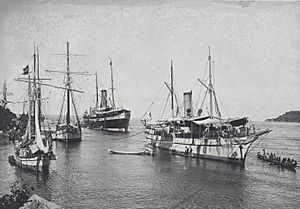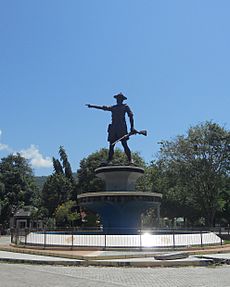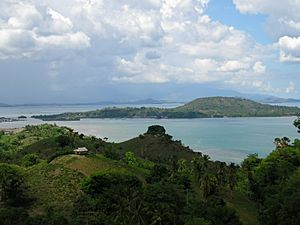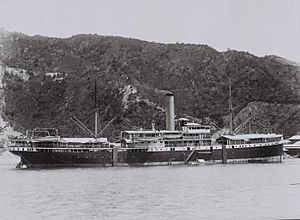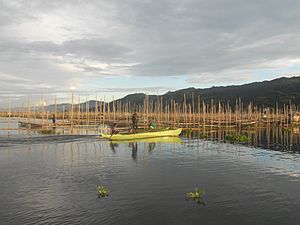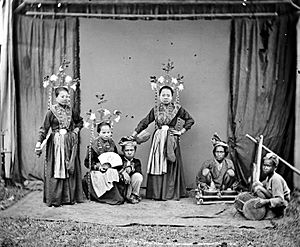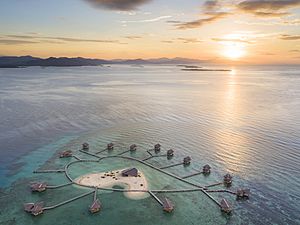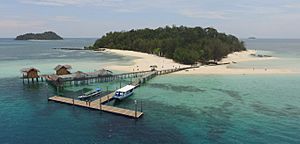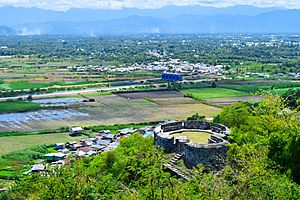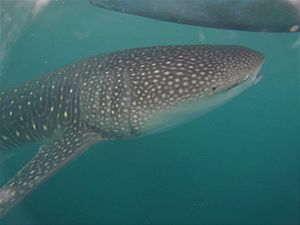Gorontalo facts for kids
Quick facts for kids
Gorontalo
Hulontalo
|
||
|---|---|---|
| Province of Gorontalo | ||
|
||
| Nickname(s): | ||
| Motto(s): | ||

Location of Gorontalo in Indonesia
|
||
|
OpenStreetMap
|
||
| Founded | 5 December 2000 | |
| Capital and largest city |
Gorontalo | |
| Government | ||
| • Body | Gorontalo Provincial Government | |
| Area | ||
| • Total | 12,025.15 km2 (4,642.94 sq mi) | |
| Area rank | 33rd in Indonesia | |
| Highest elevation
(Huidu Tentolomatinan)
|
2,211 m (7,254 ft) | |
| Population | ||
| • Total | 1,192,737 | |
| • Density | 99.19/km2 (256.9/sq mi) | |
| Demographics | ||
| • Ethnic groups | 90% Gorontaloan 10% other |
|
| • Religion (2017) | 96.7% Islam 2.19% Protestantism 0.69% Catholicism 0.38% Hinduism 0.08% Buddhism |
|
| • Languages | Indonesian (official) Gorontaloan (regional) |
|
| Time zone | UTC+08 (Indonesia Central Time) | |
| ISO 3166 code | ID-GO | |
| HDI | ||
| HDI rank | 27th in Indonesia (2022) | |
| Website | www.gorontaloprov.go.id | |
Gorontalo (also called Hulontalo in the Gorontalo language) is a province in Indonesia. It is located on the island of Sulawesi, specifically on the Minahasa Peninsula. Gorontalo used to be part of North Sulawesi province. It became its own province on December 5, 2000.
The province shares borders with North Sulawesi to the east and Central Sulawesi to the west. It also has a sea border with the Philippines to the north. The capital city and the biggest city in the province is Gorontalo.
Gorontalo covers about 12,025 square kilometers (4,643 square miles) of land. In mid-2022, about 1.2 million people lived there. This means there are about 99 people living in each square kilometer.
People sometimes call Gorontalo the "Porch of Medina". This nickname comes from a time when the old kingdoms in Gorontalo used Islamic law to guide their government and society. It is also known as "Karawo Province" because of its special local embroidery called karawo. B. J. Habibie, the third President of Indonesia, had family roots in Gorontalo.
What's in Gorontalo?
The Name Gorontalo
The name Gorontalo comes from the word Hulontalo in the local language. Hulontalo itself comes from Hulontalangi, which was the name of an old kingdom in the area.
There are a few ideas about where the name came from:
- Some say Hulontalangi means "Valley of the Noble". Huluntu means "Valley" and Langi means "Noble".
- Another idea is that Hulontalangi means "Flooded Land". Huntu means "Piles of Soils" or "Mainland", and Langi-Langi means "Flooded".
- It might also come from "Huidu Totolu", meaning "Three Mountains". There were three old mountains on the Gorontalo peninsula.
- Another theory is that it came from "Pogulatalo", meaning "Place of Waiting". This word slowly changed to "Hulatalo".
- Finally, some believe the Dutch, who ruled the area, found "Hulontalo" hard to say. So, they changed it to "Gorontalo".
People from Gorontalo sometimes call themselves Hulandalo or Hulantalo. These terms refer to the region or the people who live there.
Gorontalo's Past
Historically, Gorontalo was a very important place for spreading Islam in Eastern Indonesia. This happened even before European countries arrived. Many independent Gorontaloan kingdoms existed here.
Early History
People have lived in the Gorontalo area for about 1,300 years. Records show that a kingdom called Suwawa existed in the 8th century. An old tomb of their king, Moluadu, was found, which supports this. There are also prehistoric sites, like Oluhuta, with ancient tombs. This shows that Gorontalo has a very old history.
The city of Gorontalo is one of the oldest cities on Sulawesi, along with Makassar and Manado. It is thought to be about 400 years old, from the 1500s. Gorontalo City was a center for Islamic religion, education, and trade in Eastern Indonesia. Its location, facing both the Gulf of Tomini (south) and the Sulawesi Sea (north), made it a great trading spot.
Before colonial times, Gorontalo was ruled by traditional laws. Kingdoms were connected by a family system called "Pohala'a". There were five main "pohala'a" areas: Gorontalo, Limboto, Suwawa, Bolango (later Boalemo), and Atinggola. The Gorontalo "pohala'a" was the most well-known. Religion and customs were closely linked, with the saying "Tradition rooted in the Sharia, the Sharia rooted in the Quran".
Colonial Rule
Europeans came to Indonesia in the 16th century looking for spices. The Portuguese and Spaniards arrived first. Then, the Dutch came in 1596. In 1607, the Dutch visited the Minahasa Peninsula. The Sultan of Ternate allowed them to trade there.
The Dutch East India Company (VOC) found Gorontalo important because it had food like rice, chocolate, and coconut. There were also gold mines in the mountains. So, the VOC set up a trading post. This started official trade between the Dutch and the Gorontaloan kingdoms. The Dutch ruled Gorontalo for almost three centuries.
Japanese Occupation and Independence
During World War II, the Japanese took control of Gorontalo. This ended the Dutch rule. Gorontalo faced bombings during the war, which caused many civilian deaths.
Before Indonesia became independent, a local hero named Nani Wartabone led a movement for Gorontalo's freedom. He declared Gorontalo independent on January 23, 1942. For about two years, Gorontalo was self-governing. This inspired other independence movements in Indonesia. However, the Japanese fought against this, arresting and torturing many who wanted independence, including Wartabone. Today, Nani Wartabone is recognized as a National Hero of Indonesia.
After Japan surrendered in 1945, the Japanese handed control to local independence fighters. But the Dutch returned to take control again. This led to a war between the Dutch and Indonesian forces. Eventually, Gorontalo became part of the independent Republic of Indonesia. In 2000, Gorontalo became its own province, separate from North Sulawesi. This happened because of cultural and religious differences and as part of Indonesia's plan to give more power to local areas.
Compared to other provinces, Gorontalo is still developing. However, the government is working to improve its roads, dams, and power plants.
Geography and Nature
Gorontalo is located on the northern part of Sulawesi, known as the Minahasa Peninsula. The province is long and narrow, stretching from west to east. It covers about 12,025 square kilometers. To the north is the Sulawesi Sea, and to the south is the Gulf of Tomini. North Sulawesi is to the east, and Central Sulawesi is to the west.
The land in Gorontalo is mostly hilly. It has many mountains of different heights. Tabongo Mountain in Boalemo Regency is the highest. Many rivers also flow through the province. The Paguyaman River in Boalemo Regency is the longest, at 99.3 kilometers.
Because Gorontalo is close to the equator, it has warm temperatures. The average temperature in 2013 was between 26.2°C and 27.6°C. The air is also quite humid, with an average of 86.5% humidity in 2013. May usually has the most rainfall.
The mountains and forests of Gorontalo are home to special plants and animals. You can find rare species like the Anoa (a type of buffalo), Tarsius (the world's smallest primate), Maleo (a bird with very large eggs), and Babirusa (a wild pig). Common trees include Ebon, Lingua, and Rattan.
The Gulf of Tomini in the south is a paradise for divers. It is crossed by the equator and has many different marine animals.
How Gorontalo is Governed
The province is led by a governor and a vice-governor. People in Gorontalo vote for these leaders directly.
Areas in Gorontalo
Gorontalo province is divided into five regencies (kabupaten) and one city (kota). When the province was first created in 2000, it only had two regencies and one city. Over time, new regencies were formed from parts of the older ones.
As of 2023, here are the regencies and city in Gorontalo province:
| Name | Capital | Area (in km2) |
Pop'n estimate mid-2022 |
|---|---|---|---|
| Boalemo Regency | Tilamuta | 1,830.87 | 148,526 |
| Gorontalo Regency | Limboto | 2,160.36 | 398,801 |
| Pohuwato Regency | Marisa | 4,370.36 | 149,297 |
| Bone Bolango Regency | Suwawa | 1,889.00 | 166,200 |
| North Gorontalo Regency (Gorontalo Utara) |
Kwandang | 1,703.63 | 128,563 |
| Gorontalo City | * | 70.93 | 201,350 |
Note: * A city and also the provincial capital.
Local Government Council
The Gorontalo Regional People's Representative Council (Dewan Perwakilan Rakyat Daerah Gorontalo) is the local government body for the province. In the 2014 election, 45 representatives from different political parties were chosen to be part of this council.
Economy and Trade
Gorontalo has been an important trade route in Indonesia for a long time. Its location is good for trade with nearby countries like the Philippines, Malaysia, and Brunei. It's also a gateway for trade from the Americas to countries in Asia-Pacific. The Indonesian government sees Gorontalo as a key area for driving the economy, education, and culture in Eastern Indonesia.
The economy in Gorontalo is growing quickly. The main industries are agriculture, fisheries, and services. These sectors contribute a lot to the province's income.
To help Gorontalo grow as an agricultural province, the government is improving roads and other facilities. They also help farmers with supplies and marketing. For example, they support the growth of corn. In 2004, Gorontalo produced over 323,000 tons of corn, and some was even exported.
Gorontalo has a lot of natural resources. There are opportunities for businesses in farming and plantations, like making nata de coco or coconut oil. There are also mines for gold and granite.
The province has both flat and hilly areas, so many types of food crops can grow well. In 2006, Gorontalo produced a lot of rice, soybeans, and peanuts.
The sea around Gorontalo, especially the Gulf of Tomini, is full of potential for fishing. The province has long coastlines in both the north and south. The fishing industry is a major source of income.
People and Culture
In 2020, Gorontalo Province had about 1.17 million people. Gorontalo Regency has the most people, while North Gorontalo Regency has the fewest.
Ethnic Groups
The Gorontaloan people are the largest group in the province. They also live in parts of North Sulawesi and Central Sulawesi. There are over 1 million Gorontaloans. They are divided into subgroups called "Pohala'a," which means "Family." The main Pohala'as are Gorontalo, Suwawa, Limboto, Bolango, and Atinggola. Many Gorontaloans have moved to other parts of Indonesia or even overseas for school and work.
The Sama-Bajau people are sea nomads who originally came from the Southern Philippines. They live in villages along the coast of Gorontalo. They speak the Bajaw language, which is different from the Gorontaloan language. Most Bajau people work in fishing.
Other groups are mostly people who moved from other parts of Indonesia, like the Javanese and the Bugis. Many came through a government program called "transmigration," which helped people move to less crowded areas.
Religion
Religion in Gorontalo Province (June 2021) Islam (98.02%) Protestantism (1.46%) Hinduism (0.34%) Roman Catholic (0.09%) Buddhism (0.08%)
Like most Indonesian provinces, Islam is the main religion in Gorontalo. In 2021, about 98% of the people were Muslim. Islam is believed to have arrived in Gorontalo in the 15th century. The Hunto Sultan Amai Mosque, built in 1495 by Sultan Amai (the Gorontalo Sultanate's first Muslim king), shows this history. Today, many Islamic organizations have offices in Gorontalo.
Christianity is the second-largest religion, making up about 2% of the population. Most Christians are people who moved from other parts of Indonesia, especially North Sulawesi. There are several churches in Gorontalo, mainly in the capital city. Other religions like Hinduism and Buddhism are also practiced by people who have moved to Gorontalo.
Languages
Indonesian is the official language of Gorontalo and the country. Road signs and official papers are written in Indonesian. However, the Gorontaloan language is the most common language spoken in the province. There are also other similar languages, which linguists consider dialects of Gorontaloan. These include Suwawa, Atinggola, Limboto, Kwandang, Tilamuta, and Sumawata. The Gorontaloan language is widely used because of the influence of the old Gorontalo Kingdom.
Today, the Gorontaloan language has mixed with Manado Malay, which is also spoken by many Gorontaloans. The Gorontaloan language is related to languages from North Sulawesi and the Philippines, like Tagalog language and Cebuano language.
People in Gorontalo now use the Latin alphabet for writing. However, the Gorontaloan language is mostly used in daily life. In schools, media, and official documents, the Indonesian language is used. To help keep regional languages alive, dictionaries for Gorontaloan, Suwawa, and Atinggola languages have been published. The Quran has also been translated into Gorontaloan. Local schools also teach the Gorontaloan language. In the past, Gorontaloan was written using the Arabic-based Pegon script and its own local script called "Aksara Suwawa-Gorontalo".
Culture and Traditions
Gorontalo has unique cultural features, including special foods, traditional houses, arts, and handicrafts. One famous handicraft is the karanji upiya, a woven skullcap made of rattan.
The Gorontalo people have a family system called pohala'a. This system comes from the old kingdoms in Gorontalo. There are five pohala'as: Gorontalo, Limboto, Suwawa, Bualemo, and Atinggola. The Gorontalo pohala'a is the most well-known.
Traditional Houses
Gorontalo has several types of traditional houses. Two important ones are the Dulohupa traditional house in Gorontalo City and the Bandayo Poboide traditional house in Limboto.
Dulohupa House
In the Gorontaloan language, Dulohupa means "Consensus." This name fits because the house was used for meetings to reach agreements on traditional matters during the time of the Gorontalo kings. It was also a place to hold trials for people who committed crimes.
The Dulohupa house has a unique design. It's built on stilts with carved poles. The roof is made of woven straw, and the floors, walls, and stairs are made of wood. Inside, the house is one large room. Today, this room is used for traditional wedding ceremonies and other cultural events.
Bandayo Poboide House
The word "Bandayo" means a building, and "Poboide" means a place to talk or consult. The Bandayo Poboide house was often used for meetings and traditional theater. It's also a stilt house made of strong wood. In the past, it served as a king's palace and a meeting place for elders to discuss customs. It was also used for Gorontalo cultural performances. Now, the Bandayo Poboide house helps preserve and develop Gorontalo's arts and culture.
Handicrafts
Gorontaloan people have special clothing and accessories. Some of their unique handicrafts include:
- Upiya Karanji or Songkok Gorontalo: This cap is made from woven rattan. It's very comfortable because air can flow through it easily.
- Sulaman Karawo or Sulaman Kerawang: This is a special type of Gorontalo embroidery. It's known for its high artistic value and is popular both in Indonesia and other countries.
- Gorontalo Batik: This is similar to other Batik fabrics, but it has unique Gorontalo patterns and designs.
Martial Arts
Gorontalo has a traditional martial art called "Langga," also known as Silat Gorontalo. Langga is a type of martial art that uses hand and foot defenses and strength. It is an important part of Gorontalo's cultural heritage.
Fun Places to Visit
Gorontalo has many beautiful places to visit, especially its mountains and coastal areas. Here are some popular tourist spots:
Pulo Cinta
Pulo Cinta, which means "Love Island" in English, is in Boalemo Regency. This island is shaped like a heart and has beautiful floating resorts. It's known for its clear, charming sea. Pulo Cinta is a popular spot for both local and international travelers and is sometimes called the "Maldives of Gorontalo."
Saronde Island
Saronde Island is a top international tourism spot in Gorontalo. It's located in Kwandang, North Gorontalo. Saronde Island is famous for its white sandy beaches, clear water, and coral reefs. Many yachts from around the world stop here each year. Near Saronde, there are three other islands: Bogisa, Mohinggito, and Lampu islands.
Olele Marine Park
Olele Marine Park is a favorite underwater spot for divers from around the world, especially from Europe. It's located in Bone Bolango Regency. This marine park is famous for its unique Salvador Dalí Sponge. This type of sponge can't be found in any other marine park, not even in Bunaken National Park in North Sulawesi. It's named Salvador Dalí because it looks like a painting by the artist Salvador Dalí.
Fort Otanaha
Fort Otanaha was built by the Portuguese a long time ago. The Gorontalo Kings used it for protection and defense. What's special about this fort is that it was built using a mix of sand, plaster, and egg whites. From the fort, you can see a clear view of Lake Limboto because it's on a high hill. It's about 8 kilometers from downtown Gorontalo. There are two other forts nearby: Otahiya and Ulupahu Palace. To reach Fort Otanaha, visitors need to climb 345 steps.
Lake Limboto
Lake Limboto is a large lake in Gorontalo Regency. It covers about 3,000 hectares and is where five major rivers meet.
Botubarani Village
Botubarani Village, in Bone Bolango Regency, is a fishing village where tourists can see whale sharks. These gentle giants can usually be found there from April to July.
Images for kids
See also
 In Spanish: Provincia de Gorontalo para niños
In Spanish: Provincia de Gorontalo para niños



